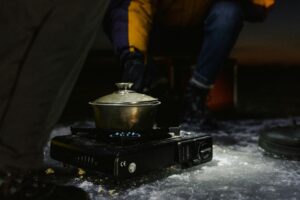How to Build a Long-Burning Campfire That Lasts All Night
A fire is more than warmth — it is light, comfort, and life itself in the wilderness. Anyone can spark flames, but building a fire that will burn strong and steady through the cold hours of night is an art. Done right, it frees you from constant tending and lets you sleep, cook, or simply enjoy the glow until dawn. Here’s how to master the long-burning campfire.
Why Build a Long-Burning Fire?
Rugged camping isn’t about convenience — it’s about resilience and efficiency. A properly built long-burn fire provides:
- Consistent warmth: Essential for cold-weather camping where temperatures can plummet overnight.
- Cooking stability: A steady coal bed makes for predictable cooking heat.
- Safety: A single, well-built fire reduces the need to stumble around in the dark adding logs every 20 minutes.
- Efficiency: Conserves wood by burning fuel completely and slowly.
- Morale: A glowing fire at dawn can lift spirits after a long, cold night.
Safety & Leave No Trace Principles
Before striking a spark, keep in mind that a campfire is a responsibility:
- Check regulations: Ensure there are no fire bans or restrictions in your area.
- Choose your site wisely: Use an existing fire ring if possible. If not, build on bare mineral soil or a fire pan. Avoid moss, peat, or root systems that can smolder underground.
- Clear the area: Remove leaves, pine needles, and flammable debris in at least a 2m (6 ft) radius.
- Keep tools nearby: Always have water, sand, or dirt and a shovel ready to fully extinguish the fire.
- Respect the land: When you leave, there should be no trace of your fire beyond faint cold ashes.
The Science of a Long Burn
A fire that lasts the night isn’t about adding more logs — it’s about controlling three key factors:
- Fuel density: Dense, dry hardwoods like oak, maple, or birch burn slower and hotter than softwoods. If hardwoods aren’t available, use the thickest spruce or pine rounds you can split.
- Airflow: Too much oxygen and the fire will roar then die quickly. Too little and it will smoke and choke. The goal is a balance that sustains steady combustion.
- Coal bed: A deep bed of glowing embers holds heat for hours, reigniting larger fuel from below as the fire settles.
Gathering & Preparing Wood
Think of firewood in three categories:
- Tinder: Birch bark, fatwood shavings, cotton balls in petroleum jelly, or feather sticks. You only need a handful, but it must ignite instantly.
- Kindling: Small sticks no thicker than a pencil, then thumb-thick sticks. Collect more than you think you’ll need.
- Fuel: Medium splits for sustaining flames, and large rounds (10–20 cm / 4–8 in diameter) for the overnight burn.
Tip: Stage your wood by size and keep a reserve covered from rain or snow. A fire is only as reliable as its fuel prep.
Method 1: The Top-Down Fire
The top-down (or “upside-down”) fire is ideal for steady, overnight burns. Instead of starting small and piling fuel on top, you reverse the order so the fire feeds downward.
- Base: Lay 3–4 of your largest logs tightly side by side, creating a solid foundation.
- Second layer: Place slightly smaller logs perpendicular to the base.
- Third layer: Add medium splits crosswise, leaving small gaps for airflow.
- Kindling platform: Build a log cabin or teepee of kindling on top and place tinder in the center.
- Ignite: Light the top layer. Flames burn downward, igniting progressively larger fuel.
Overnight strategy: Once the top collapses into coals, rake embers down between the bottom logs. Add one or two large rounds at the sides to extend the burn until morning.
Method 2: The Long-Log Fire (Rakovalkea)
Used for centuries in northern climates, this Scandinavian design creates radiant side heat and can burn for 6–8 hours with minimal tending.
- Pick two big logs: Straight, 1.5–2 m (5–6.5 ft) long, and 15–25 cm (6–10 in) thick.
- Lay the base log: Rest it slightly elevated on stones for airflow.
- Spacer sticks: Lay green sticks or metal rods across the base log every 30–40 cm (12–16 in).
- Place the top log: Rest it on the spacers so a narrow air gap runs between the logs.
- Ignite: Start a fire at one end of the gap with kindling. The fire will spread gradually along the logs.
Pro tip: Sleep parallel to the long fire, a safe 1.5–2 m away, letting it throw even heat toward your shelter. This is one of the most efficient long-burn designs for winter survival.
Alternative Overnight Fire Designs
- Pyramid Fire: Stack logs in progressively smaller layers like a pyramid. Burns steadily as layers collapse inward.
- Star Fire: Place large logs radiating outward from a central flame. Push logs inward as they burn. Good for group camps.
- Log Cabin Fire: A square, crisscross structure that collapses inward. Excellent for creating a strong coal bed.
Wood Choices for the Long Burn
- Best hardwoods: Oak, maple, beech, birch. Long, hot, steady burn.
- Best softwoods: Spruce, pine, fir. Burn faster but good for starting coals.
- Avoid: Rotten wood (burns fast, no coals), green wood (smokes heavily), and resin-heavy scraps near camp (spark risk).
Banking Coals for the Morning
Even when the flames die, coals can keep smoldering for hours. To save your fire for the next day:
- As the fire wanes, rake coals into a dense pile.
- Cover lightly with ash to insulate and reduce airflow.
- At dawn, uncover, add kindling on top, and gently blow or fan until flames return.
This simple trick can save you from starting over entirely in the morning.
Troubleshooting Common Problems
- Fire dies quickly: Base logs were too small. Use thicker rounds.
- Too much smoke: Wood was wet or airflow restricted. Add a small draft gap.
- Burning too fast: Too much wind exposure. Build a partial windbreak.
- Struggling to ignite: Not enough kindling. Triple your supply and restart.
Overnight Checklist
- Camp positioned upwind and away from sparks.
- Water and shovel at hand.
- Extra logs staged for quick addition.
- Before bed, consolidate coals and add a final large round.
Extinguishing the Fire Properly
- Spread remaining logs and coals thinly.
- Douse with water. Stir. Douse again until completely silent and cold.
- Scatter ashes widely and restore the fire site if you created one.
Final Thoughts
Building a long-burning campfire is part skill, part patience, and part respect for the elements. It is not about throwing wood on a pile, but about arranging fuel, managing airflow, and reading the fire’s behavior. Whether you’re camping in the crisp air of autumn, the deep cold of winter, or the quiet solitude of the mountains, mastering this skill ensures that your fire is a reliable companion through the night.
Respect the land, respect the flame, and let your fire carry you from dusk to dawn.








